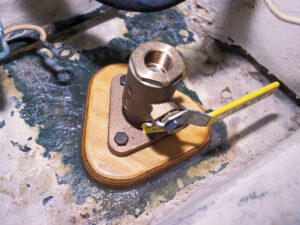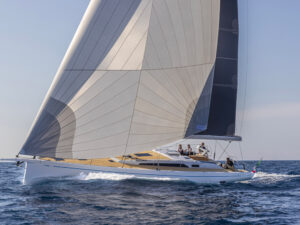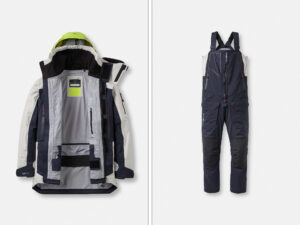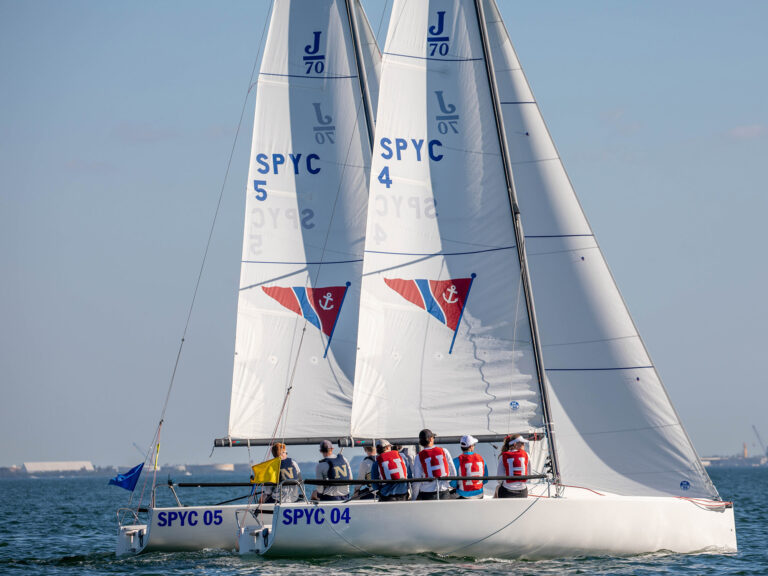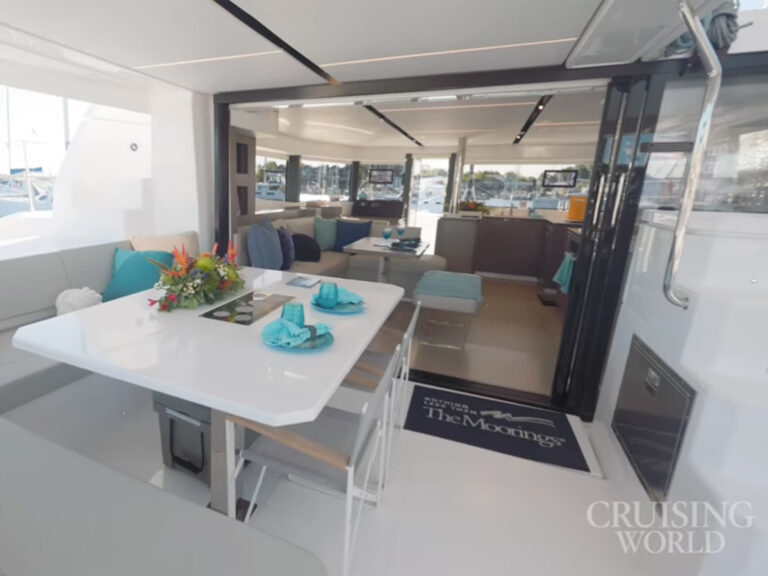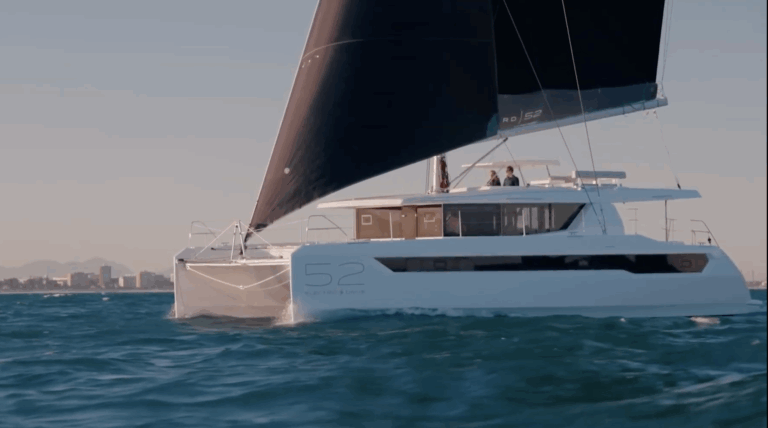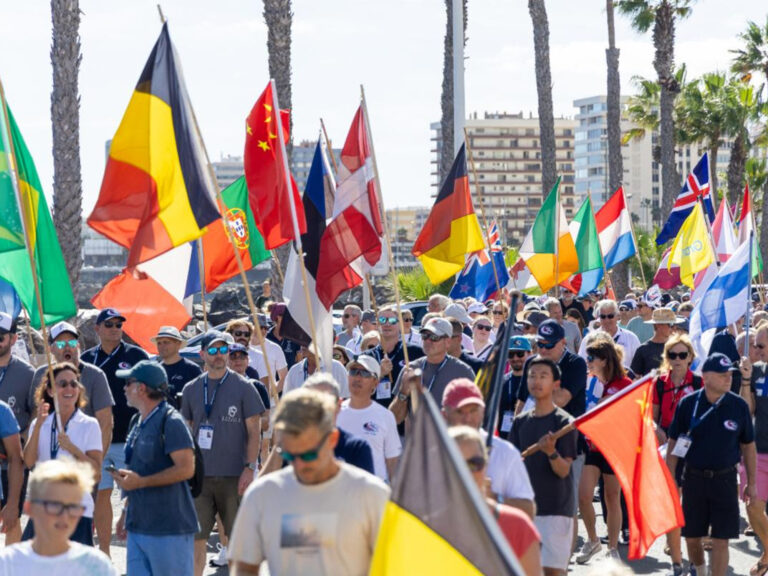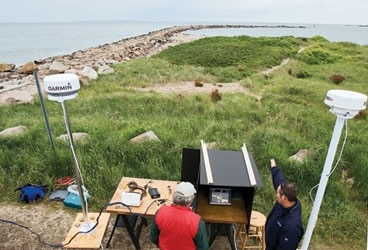
Radar368
Radar — the acronym for radio detection and ranging — is certainly one of the greatest inventions of the last century, and the first few years of the present one have brought on significant breakthroughs in software and systems. Today’s equipment is easy enough to install and use that it’s become commonplace on most boats heading offshore.
So given the improvements in size, functionality, accuracy, and affordability, CW decided last summer to take a look at the new generation of 2- and 4-kilowatt radomes to see if the increased transmitting power of the latter translates into results worth the added expense.
We spent two days in late June on Rhode Island’s shoreline, where we set up a dozen radomes-the plastic-covered radar antennas most frequently seen on sailboats-and displays, then put them through their paces using a combination of fixed and moving targets.
What did we find? The short answer is that more kilowatts are better. But the longer answer is that the buyer needs to weigh a number of factors when deciding which unit will be best for a particular boat and user. Radome size, power consumption, ease of use, and the operator’s skill level all come in to play. Add enough computing power and technical wizardry on one end, and you could end up with a 2-kilowatt unit that outperforms a rival’s 4-kilowatt radar-if the operator knows which dials to twist.
Designing the Test
We chose the Camp Cronin fishing-access site at the northeastern corner of the Harbor of Refuge in Point Judith as our test site because of the nearby buoys and fixed daymarks for close-range target acquisition and because Block Island stands about nine miles offshore and provides a good target for long-range assessment. In addition, the many passing ships, barges, and fishing boats provided good moving targets.
All were invited, but the manufacturers that agreed to take part were Furuno, Garmin, Icom, Lowrance, Northstar, Raymarine, and Simrad. In addition to equipment, all but Simrad also sent technicians to assist with setup and radar tuning. Worth a mention is that a new player in this arena, Interphase Technologies, learned of the test too late and wasn’t included.
Over the two days of testing, after each radome and display was assembled and tuned, we determined how well each one acquired close- and long-range targets. We weren’t interested in comparing the chart-overlay or target-tracking features found on all of the new units; rather, we wanted to see if more power is categorically better in terms of detecting targets. We thought this would be important to quantify because 4-kilowatt radomes are now offered by all major manufacturers as an alternative to the nearly ubiquitous 2-kilowatt antennas on radar-equipped cruising boats. In fact, two of the manufacturers, Garmin and Icom, have dropped their lines of 2-kilowatt antennas entirely, perhaps indicating the direction of the market.
Kilowatts are a measure of a radar unit’s transmitting output. Theoretically, more is better, but one of the big roadblocks over the years has been the large antenna size of the more powerful units and the space limitations typical to cruising sailboats for mounting the antenna. For this reason, we didn’t test open-array antennas. We focused on radomes, which in diameter commonly measure 18 inches (2-kilowatt) to 24 inches (4-kilowatt). For the purpose of our test, we used Edson radar masts that would be typical mounts on the stern of a sailboat. West Marine also loaned us inflatable Echomax Radar Reflectors; when deflated, they fold up for easy storage, and inflated, they’re about the size of a fender, providing a good target.
How They Stacked Up
After working with all the units, and with our observations and photos in hand, it became fairly easy to draw some conclusions about the various radars currently on the market. Keep in mind that whenever I perform these comparison tests, I always enter into my analysis by specifically ignoring unit pricing; I don’t want to know the cost for fear that my thoughts may wander to something like “Well, for the price, this unit seems pretty good.” It’s only at the very end of the analysis that I consider cost, and in this case, we saw quite a spread that indeed could sway someone’s choice.
Both the Furuno and Raymarine units exhibited excellent radar performance in all our tests, with the Furuno radars slightly edging out the Raymarine radars in longer-range performance. In fact, the 2-kilowatt units from both these manufacturers outperformed the 4-kilowatt units of some other vendors. This was due in part to some of the other manufacturers opting for ease of use over operator-control settings. In some of the systems tested, software running behind the scenes automated many of the fine adjustments that can improve target definition, making the units easier to use, but the resulting screen views were less defined. This, of course, is one of the many tradeoffs a buyer will want to consider when it comes time to make a purchase.
Comparing Furuno’s and Raymarine’s 2-kilowatt radars against their own 4-kilowatt models showed a clear edge with the higher power. Raymarine seems to have mastered the power-consumption factor better than Furuno, and for some buyers, this may make a difference. When transmitting, electrical-current draw for Raymarine’s 4- and 2-kilowatt radars was 4.4 amps and 3.8 amps, respectively, compared with Furuno’s 5.6 and 5.0 amps for its 4- and 2-kilowatt units. Current draw is a total of the power consumed both by the antenna and by the display unit or other related equipment. Also, looked at as a package, the Raymarine displays and radomes we tested came in at lower price points, so that may be a factor when making a purchasing decision.
The Garmin unit was unique among our test group with its touch-screen display and elegant software interface. We found its actual radar performance just a notch below that of both the Furuno and Raymarine units but either “Very good” or “Excellent” on our larger scale. It seemed during our testing that the Garmin software designers made a real effort to eliminate screen “noise” with its gain, fast-time constant (FTC), and sensitivity time control (STC) circuitry, but in doing so, they may have gone slightly too far. The unit didn’t provide quite the same level of target definition as the Furuno or Raymarine units. Also, the display screen used by Garmin appeared to have significant electrical-current draw. Even in standby mode the unit pulled 4.7 amps, nearly twice that of all the other units. This wouldn’t be a concern in the powerboat market or to a sailor who motors a fair amount, but it’s a cause for pause if most of your voyaging will be done under sail. That said, the Garmin software features made these units quite easy to set up and use, and in terms of price, it was about in the middle of the 4-kilowatt models. For someone a bit techno-queasy who wants a good touch-screen interface or for anyone looking to plug and play quickly, this is well worth considering. Also, Garmin has managed to get a 4-kilowatt antenna into an 18-inch radome, unique among our test units.
Also unique in our test group was the Icom radar. It was the only one that used a CRT (cathode-ray tube) display, and the display wasn’t designed for multipurpose use, meaning that the screen couldn’t double as a chart plotter, fish-finder, or weather screen. The company’s 4-kilowatt model performed very well across the board; we rated it slightly behind the Garmin. Considering that it was also the least expensive unit we looked at by a fairly broad margin-a total cost of $2,500 for radome and display-I give it high marks for value. Because it’s simple to use and has a traditional layout and controls with more-than adequate performance, I liked this unit as a pure radar set.
Northstar came to our test with a bevy of gear that included both 2- and 4-kilowatt radomes and two different display screens, an 8.4-inch unit and a 12.1-inch unit; the performance of these devices ranged from excellent to fair. At the top end, the larger display married to the 4-kilowatt antenna served up performance that approached Raymarine’s and Furuno’s. In terms of radome-to-radome comparisons, the 4-kilowatt antenna, when viewed with either display, was clearly an improvement over the 2-kilowatt model when it came to target definitions, particularly with long-range shoreline definition; the lower-power model rated only a score of “Fair” in this metric. Also, the 12.1-inch display helped to enhance the overall view since images appeared larger and more easily identifiable. One of the most interesting results was that in either standby or transmit mode, the larger display unit (a newer design) consistently drew less power than the smaller unit, a testament to the small but significant improvements in technology that occur as these products evolve.
Lowrance, long known for its fish-finder technology, came to the test with its LCX-112C display and both 2-kilowatt and 4-kilowatt antennas. Both of these units are in the low end of the price spectrum for our test group, but in terms of actual performance, we located these units at 6th in our brand ranking-adequate, but a notch below most of the others.
Rounding out the field, Simrad provided a 10-inch display and both a 2- and 4-kilowatt antenna for testing. A company long known for its high-end commercial-grade electronic equipment, the displays and gear it provided for this test had the usual “solid as a rock” feel for which Simrad is known. The gear is built tough, and that should prove itself in terms of longevity. For the record, we’d note that this was the only manufacturer that didn’t have a representative on hand to assist with setup and tuning, and we can’t say if this affected the performance. But the field of experts who were present all gave their absolute best shot at fine-tuning the units provided. The company’s 2-kilowatt radar did an adequate job of tracking moving targets, and by our measure, it slightly outperformed the 4-kilowatt model when it came to both long- and close-range shoreline definition, somewhat of an anomaly when compared with the other units we examined.
Overall, shoreline definition on both units was cluttered when compared with most of the rest of the radars tested, despite our attempted tuning. At long range, the Simrad units certainly picked up the same targets as the others but, again, with a lesser degree of clarity. Based on the average retail price quoted by the manufacturers, these units also landed in the most-expensive category.
Don’t Forget the Systems Approach
We’d be remiss if we didn’t point out that in our test, we were looking at raw radar performance and the specific difference between 2- and 4-kilowatt transmitters. There are several other aspects that come into play when a radar is installed alongside a sailboat’s other navigation equipment. With the exception of the Icom unit we tested, all of the other manufacturers take a “systems approach” to their radar units. Their sets are designed and engineered to be integrated with chart plotting, MARPA (Mini Automatic Radar Plotting Aid) capability, radar-overlay-over-chart cartography, and, possibly, with depth information and weather-chart overlay. Buyers should consider all of these potential capabilities and compare systems carefully before making a final decision. It may well be that a more user-friendly interface or radar-overlay functionality will outweigh subtle differences in actual radar performance. So consider all that we’ve presented here, but if you’re contemplating setting up a new boat or you’re upgrading the electronics on an older boat, take a systems approach in your decision-making process.
Common Radar Terms
Antenna rotational speed: The speed at which the radar antenna rotates can have a pronounced effect on target accuracy and tracking with regard to high-speed vessels moving through the water and when the radar’s range is decreased. Some units stick to a fixed rotational speed; others change speed as the range on the radar is adjusted; still others are completely automatic. Higher antenna rotational speed usually helps here in a big way.
Beam angle (horizontal): This is the specification that gives insight into a radar unit’s ability to separate targets that are close together, such as a tugboat towing a barge. The smaller the beam-width angle, the more theoretical resolution the unit will have for identifying these close-together targets and the better job it will do in illustrating landmass contours and shoreline shape. Typical angles for the horizontal beam width of recreational radar range from about 1.1 degrees to 7 degrees. Narrow horizontal-beam-width antennas are by their nature longer and provide a beam width in the 1-degree to 3-degree range. But these antennas are “open array” and not enclosed in a radome; in general, these aren’t practical on a midsize cruising sailboat. Of the units we tested, all were radomes, and those with horizontal-beam-width specifications in the 3- to 5-degree range would offer better theoretical target separation than those with a 6- or 7-degree horizontal-beam-width angle.
Beam angle (vertical): Vertical beam angle, combined with antenna mount height and transmitter pulse length, will control a radar unit’s minimum range capability. All of the units we compared had a vertical-beam-width angle between 24 and 26 degrees. This means that the projected angle of visibility from the antenna is equivalent to 12.5 degrees downward and 12.5 degrees upward. If the antenna is mounted too high, then the angle cuts off nearby objects because they won’t be visible to the radar’s projected beam angle.
Fast-time constant: Related to gain, FTC controls the radar’s ability to discriminate against rain and snow clutter specifically. Both can be compensated for by adjusting rain- and sea-clutter levels.
Gain: An all-important adjustment to a radar, gain is used to control unwanted interference or electronic “noise.” Set the gain too high and it decreases the radar’s sensitivity to a level that’s nearly useless.
Interference reduction: Several areas of concern for radar users are the effects of interference from other nearby radars or radio transmitters and a phenomenon known as “side-lobe echoing.” Historically, these phenomena have caused such problems as the disappearance of weak targets or the mysterious appearance of “false echoes” on the radar screen. Advances in signal processing, such as “pulse profiling,” allow engineers to better “shape” the radar beam and have gone a long way toward minimizing these problems. In most cases, the interference issues are dealt with automatically by the current crop of new radars. That said, Icom, for example, does offer an explanation of the side lobe phenomenon in its literature and explains how to manually adjust its unit to minimize this effect. As for the radio-interference issue, if antennas are mounted according to the manufacturer’s instructions, this problem shouldn’t be an issue with today’s radar units.
Pulse width: A radar sends out a pulsing signal when it’s transmitting that’s often stated as a specification in pulse-repetition frequency (PRF), typically measured in microseconds or nanoseconds. The shorter the pulse duration, the faster the radar can receive the return echo and calculate the distance to a given target. Since radar is both a transmitter of a signal and a receiver of a return signal, this ever-so-brief time delay is what’s needed to give the unit time to differentiate between transmitted and received signals. During these brief time delays, the radar will “paint” its target(s) on the display screen every time a new pulse is transmitted. In simple terms, the higher the PRF that’s used, the more a target can be painted. In general, it’s safe to say that units that advertise more pulse-width adjustments at different transmitting frequencies or ranges are offering a higher level of sophistication and will probably deliver better target definition.
Rain clutter: During heavy rain, the radar’s transmitted signal is reflected by the drops themselves. This can make the display screen a total mess when your radar tries to pick out the individual raindrops! As with sea clutter, one can compensate for this, but look for the fine line between clarity and desensitivity.
Sea clutter: Heavy seas and breaking waves confuse radar’s ability to pick out landmasses, aids to navigation, and other boats and ships because the waves become targets as well. This needs to be tuned out so that the targets of concern are what you’re seeing. Again, overdoing it here desensitizes the radar and may cause “real” targets to be missed.
Sensitivity time control: STC helps to overcome one of the shortcomings of simple gain controls. STC helps to control the gain by electronically dealing with return signals of widely varying strength. With targets both near and far, gain by itself has trouble adjusting to render the perfect picture. STC circuitry helps to compensate for this inherent shortcoming.
Radar-Performance Factors
Besides the various hardware factors that contribute to radar’s performance, today’s units rely heavily on software to control settings and to interpret the data. Many of the differences in performance that we experienced were based on each manufacturer’s effort to maximize the controlling software that in effect is fine-tuning the radar’s critical adjustments in real time. Some do it better than others. Controls for adjusting sea clutter, gain, transmit pulse timing, and antenna rotational speed, can make a significant difference in what you see on screen and in such performance issues as the ability to track a fast-moving target. To that end, we let manufacturer reps perform the final setup and adjustments to their units to ensure that everything was adjusted to their satisfaction. Once that process was complete, we left the units in auto mode, with the exception of range adjustments for our short- and long-range observations.
As for performance in inclement weather, we had the benefit of crystal-clear blue skies during both days of testing. It’s a long-standing belief, however, that in fog or rain, greater transmitting power-4 kilowatts rather than 2-will always help in punching the radar’s signal through the haze to find targets of concern to the navigator.
Where the radar is mounted also has a bearing on its performance because antenna height and target height are determining factors in actual radar range. Radar is what is generically called a line-of-sight system, meaning that it can see targets to the horizon. But the truth is that atmospheric refraction actually bends the radar’s beam slightly, and the net effect is that radar can actually see about 15-percent farther than a human observer at the same height. The height of targets beyond the visible horizon determines the actual radar range.
While most radars feature range settings approaching 48 miles, in all practicality, these are only useful for spotting weather systems or tall coastal features. When cruising, setting the radar on an 8-mile range is a good working distance to detect approaching traffic or hazards, and you can scan in tighter for more detail on closer targets.
A final word about performance: While it might be tempting to locate a radar antenna as high on your mast as possible, this could create a dangerous blind spot around your boat because of the vertical beam width of a radar’s pulse. Say that your radar’s beam width is 25 degrees; you’ll need to project a line 12.5 degrees above and below the antenna to see where this blind spot will fall.
Power Consumption by Radar
For cruising sailors, electrical-power consumption is always a concern. Radar is a fairly heavy power consumer in transmit mode because the device needs power to run its internal electronic circuitry, light a display screen, and power the antenna motor. We measured power usage for all of the units in our test in both standby mode and transmit mode to get a real-world comparison of the electrical needs of the units. It’s important to remember that today, with most of the units employing full-color day-bright display screens, power management is a real challenge for design teams. On some boats, every amp counts when battery capacity is limited. Typical current draw ranges from 2 to 6 amps, so for some buyers, this may be a deciding factor in which unit gets selected. High-amperage consumption simply equates to more engine run time to keep batteries charged.
Ed Sherman serves as the curriculum designer and senior instructor for the education programs at the American Boat & Yacht Council. His most recent book, “Advanced Electrics and Electronics Troubleshooting,” was released earlier this year by McGraw Hill/International Marine.

